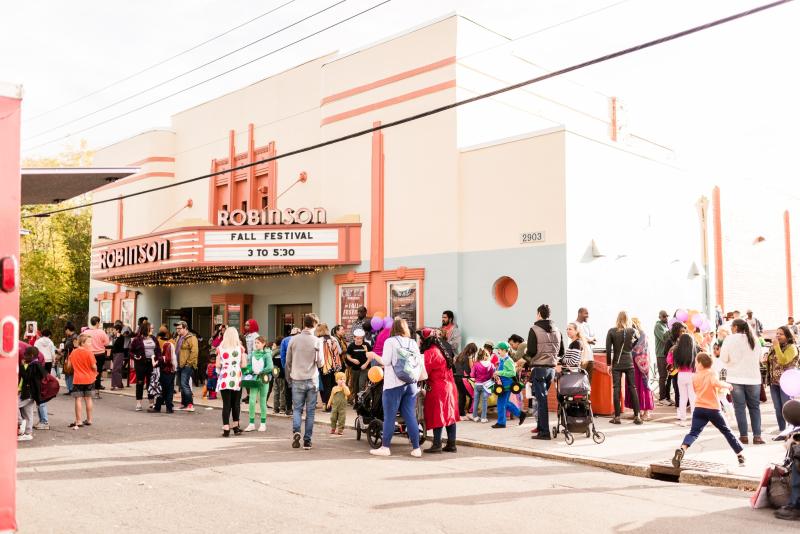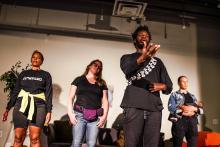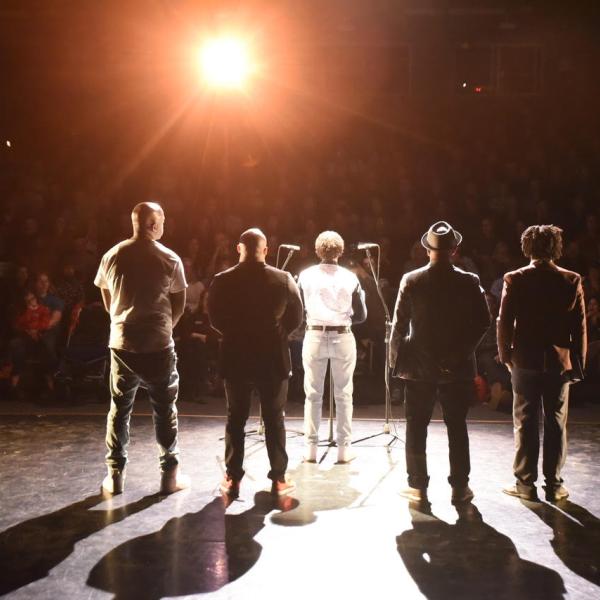ARP Grant Spotlight: Richmond CultureWorks (Richmond, VA)

Community members gather at an event hosted by Robinson Theater Community Arts Center. This annual Fall Festival event highlights local arts, artists, and nonprofit arts and culture organization. Robinson Theater, a Richmond CultureWorks grantee, is a multi-purpose facility that exists to inspire, encourage, and restore healthy. Photo by Meghan Pyle.
Richmond, Virginia, is a city that sees its streets as a canvas for creativity. Over the past seven years, more than 150 murals have decorated buildings downtown, and both local and national artists have shared their work at the more than 15 galleries in downtown Richmond. From shows to exhibitions, Virginia’s political capital was also becoming a cultural capital for the state, but much of Richmond’s creative industry came to a halt in 2020 with the onset of the Covid pandemic.
“I was worried because when things get tough, arts and culture is often one of the first things that localities might cut investments in,” said Scott Garka, president of Richmond CultureWorks, the area’s local arts agency. “But arts and culture are a big part of what makes Richmond what it is, and we saw individuals, businesses, foundations and even most of our localities continuing to invest in arts and culture.”
To aid in pandemic recovery, CultureWorks also received a $250,000 American Rescue Plan grant from the NEA to support their staff, and individual artists and arts and culture organizations in the Richmond and Tri-Cities region.
“I think local arts agencies like ours have the connection to be able to get to the people that this legislation (the American Rescue Plan Act) was trying to reach. We have an existing model and this funding allowed us to remain committed to reaching out to the artists and nonprofit organizations in the community,” said Shelby Finkelstein, Advancement and Grants program strategist at CultureWorks.
With this federal grant, CultureWorks regranted the funds to arts and culture organizations in their community. Their subgrant program targeted grants toward organizations with budgets of less than $750,000 and those serving historically underserved groups. This included small theaters and other performance groups, dance groups, youth performance groups, musicians, and contract artists who provide programming in moderate income neighborhoods and to people with disabilities.
Prior to the distribution of federal NEA American Rescue Plan funding, individuals and businesses came together to help support local artists. Garka says that some individuals who received a stimulus check during the pandemic donated their stipend to CultureWorks.
“There were people who said, ‘I still have my job, but I want to make sure that the arts are still here when this is all over,’ and they donated their stimulus checks to the relief fund. That was absolutely amazing. Artists were really struggling and they were unable to show their work. They were unable to put on shows for the performing arts or generate any revenue. Many of our artists are so-called ‘starving artists’ who also have side gigs to make ends meet. And many of those side gigs are in the hospitality industry, which was hit just as hard as arts and culture,” said Garka.
In the end, after a foundation seeded $20,000, individual and corporate donations amassed a nearly $300,000 emergency relief fund that went directly to individual artists. During this period of uncertainty, 394 artists were each granted $500 to support their pandemic recovery in addition to 21 local arts organizations.
“Initially, we were concerned that $500 wouldn’t make a difference, but the letters that we got back said it was incredibly meaningful not only to provide financial support, but also to be seen by the community,” said Garka.
In 2022, NEA funding tripled the amount of funding that Richmond CultureWorks typically has the opportunity to grant; however, Garka observed that the need from local arts organizations was still present.
“When we had a $100,000 grant pool, we typically saw demand for our grants versus those being funded was a 3:1 ratio, and I thought, ‘Well, surely with more funding, we'll be able to knock that down some,’ but due to our efforts to reach new audiences and new applicants, that ratio remained the same despite the funds being tripled,” said Garka.
To help address this gap of need in creative ways, CultureWorks also helped facilitate partnerships and relationships between organizations.
“One of our key goals is to drive collaboration; not just among the arts organizations, but with the local governments, with the local businesses and so forth. Some of the greatest things we've accomplished have been in partnership with other entities,” said Finkelstein.
An example of these successful partnerships took place with the bus system in Richmond, where Greater Richmond Transit Company (GRTC), RISE for Youth, Performing Statistics, and Culture Works partnered to launch a campaign called, “Freedom Constellations.” Part of this community engagement involved developing a bus wrap with a design produced by young activists and local artists. In addition to portraits of the youth, the bus wrapping included phrases like: “We dream of a world where all youth are free. We can love ourselves. We can shape our future. We are free.” This effort was done to help raise awareness of and disrupt the youth school to prison pipeline and ensure every space that impacts a young person’s life encourages growth and success.
Performing Statistics also worked with Rise for Youth and CodeVA to create a multi-media mural envisioning the joy, freedom and power made possible by a world without youth prisons, across the street from the place department in Richmond.
In recognizing that arts organizations are still struggling and navigating new realities, CultureWorks strives to make an even larger impact as the region recovers from the pandemic.
“Our mission is to strengthen artists and arts and culture organizations to drive a greater impact in the community. And when we talk about impact, we talk about economic impact, education impact, and social impact. Our arts and culture is beautiful and it influences so much on a personal level, but it also drives community impact and that's really what we're trying to harness through CultureWorks,” said Garka.





